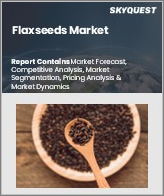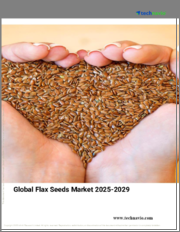
|
시장보고서
상품코드
1734500
아마씨 시장 규모, 점유율, 성장 분석 : 제품별, 용도별, 유통 채널별, 지역별 - 산업 예측(2025-2032년)Flaxseeds Market Size, Share, and Growth Analysis, By Product (Flax Seed Oil, Ground Flax Seed), By Application (Food Industry, Animal Feed), By Distribution Channel, By Region - Industry Forecast 2025-2032 |
||||||
아마씨 세계 시장 규모는 2023년에 8억 6,520만 달러로 평가되었으며, 2024년 9억 9,580만 달러에서 2032년까지 30억 6,760만 달러로 성장하고, 예측 기간(2025-2032년) 동안 CAGR 15.1%로 성장할 전망입니다.
세계 아마씨 시장은 고단백질, 고섬유질, 고오메가 3 함량으로 인한 아마씨에 대한 수요가 특징인 식물성 영양에 대한 소비자의 선호도가 높아짐에 따라 견인되고 있습니다. 아마씨 씨앗은 식품, 영양 보충제, 사료 산업에서 인기를 얻고 있으며, 건강 지향의 증가와 동물성 식품으로부터의 식습관 변화로 인해 시장이 꾸준히 성장하고 있습니다. 채식주의와 채식주의자의 급증은 기름, 밀가루, 볶은 씨앗과 같은 아마씨 제품에 대한 수요를 더욱 증가시켰습니다. 무글루텐, 고섬유질 식단, 클린 라벨, 비 유전자 변형 등의 트렌드가 제품 혁신을 형성하고 있습니다. 기능성 식품과 건강보조식품에 아마씨 씨앗을 첨가하여 항염증 효과를 강조하고, 화장품 분야는 아마씨 오일의 유용성을 발견하고 있습니다. 전반적으로, 영양가 높은 성분에 대한 소비자의 선호도 변화에 힘입어 시장 확대의 잠재력은 매우 큽니다.
목차
소개
- 조사 목적
- 조사 범위
- 정의
조사 방법
- 정보 조달
- 2차와 1차 데이터 방법
- 시장 규모 예측
- 시장 가정과 제한
주요 요약
- 세계 시장 전망
- 공급과 수요 동향 분석
- 부문별 기회 분석
시장 역학과 전망
- 시장 개요
- 시장 규모
- 시장 역학
- 성장 촉진요인과 기회
- 성장 억제요인과 과제
- Porters 분석
주요 시장 인사이트
- 주요 성공요인
- 경쟁 정도
- 주요 투자 기회
- 시장 생태계
- 시장 매력 지수(2024년)
- PESTEL 분석
- 거시경제 지표
- 밸류체인 분석
- 가격 분석
- 고객과 구매 기준 분석
- 원재료 분석
아마씨 시장 규모 : 제품별·CAGR(2025-2032년)
- 시장 개요
- 아마씨유
- 분쇄 아마씨
- 홀 아마씨
아마씨 시장 규모 : 용도별·CAGR(2025-2032년)
- 시장 개요
- 식품 업계
- 아침식사용 시리얼
- 베이커리 제품
- 에너지 바
- 기타
- 동물 사료
- 기타
아마씨 시장 규모 : 유통 채널별·CAGR(2025-2032년)
- 시장 개요
- 비즈니스 투 비즈니스
- 비즈니스 투 소비자
- 하이퍼마켓·슈퍼마켓
- 편의점
- 전문점
- 온라인
아마씨 시장 규모·CAGR(2025-2032년)
- 북미
- 미국
- 캐나다
- 유럽
- 독일
- 스페인
- 프랑스
- 영국
- 이탈리아
- 기타 유럽
- 아시아태평양
- 중국
- 인도
- 일본
- 한국
- 기타 아시아태평양
- 라틴아메리카
- 브라질
- 기타 라틴아메리카
- 중동 및 아프리카
- GCC 국가
- 남아프리카공화국
- 기타 중동 및 아프리카
경쟁 정보
- 상위 5개사의 비교
- 주요 기업의 시장 포지셔닝(2024년)
- 주요 시장 기업이 채용한 전략
- 최근의 시장 동향
- 기업의 시장 점유율 분석(2024년)
- 주요 기업 개요
- 기업 상세
- 제품 포트폴리오 분석
- 기업 부문별 점유율 분석
- 매출 전년비 비교(2022-2024년)
주요 기업 개요
- Archer Daniels Midland Company(USA)
- Cargill Incorporated(USA)
- TA Foods Ltd.(Canada)
- Richardson International Ltd.(Canada)
- Johnson Seeds Ltd.(Canada)
- AgMotion Inc.(USA)
- CanMar Foods Ltd.(Canada)
- Simosis International Inc.(India)
- Stokke Seeds(USA)
- Sunnyville Farms Ltd.(Canada)
- Linwoods Health Foods Ltd.(UK)
- Grain Millers Inc.(USA)
- Healthy Food Ingredients LLC(USA)
- Healthy Oilseeds LLC(USA)
- Bob's Red Mill Natural Foods Inc.(USA)
- Shape Foods Inc.(Canada)
- Pragati Agribiz Pvt. Ltd.(India)
- BTL Herbs and Spices Pvt. Ltd.(India)
- Eastmade Spices and Herbs Pvt. Ltd.(India)
결론과 제안
ksm 25.06.13Global Flaxseeds Market size was valued at USD 865.2 million in 2023 and is poised to grow from USD 995.8 million in 2024 to USD 3067.6 million by 2032, growing at a CAGR of 15.1% during the forecast period (2025-2032).
The global flaxseeds market is driven by a rising consumer preference for plant-based nutrition, characterized by the demand for flaxseeds due to their high protein, fiber, and omega-3 content. This increasing health consciousness and dietary shift away from animal products have resulted in steady market growth, as flaxseeds gain popularity across the food, nutraceutical, and animal feed industries. The surge in veganism and vegetarianism further fuels demand for flaxseed products like oil, flour, and roasted seeds. Trends toward gluten-free, high-fiber diets and clean-label, non-GMO offerings are shaping product innovation. Flaxseeds' incorporation in functional foods and dietary supplements underscores their anti-inflammatory benefits, while the cosmetics sector finds utility in flaxseed oil. Overall, the potential for market expansion is significant, driven by evolving consumer preferences for nutrient-rich ingredients.
Top-down and bottom-up approaches were used to estimate and validate the size of the Global Flaxseeds market and to estimate the size of various other dependent submarkets. The research methodology used to estimate the market size includes the following details: The key players in the market were identified through secondary research, and their market shares in the respective regions were determined through primary and secondary research. This entire procedure includes the study of the annual and financial reports of the top market players and extensive interviews for key insights from industry leaders such as CEOs, VPs, directors, and marketing executives. All percentage shares split, and breakdowns were determined using secondary sources and verified through Primary sources. All possible parameters that affect the markets covered in this research study have been accounted for, viewed in extensive detail, verified through primary research, and analyzed to get the final quantitative and qualitative data.
Global Flaxseeds Market Segments Analysis
Global Flaxseeds Market is segmented by Product, Application, Distribution Channel and region. Based on Product, the market is segmented into Flax Seed Oil, Ground Flax Seed and Whole Flax Seed. Based on Application, the market is segmented into Food Industry, Animal Feed and Others. Based on Distribution Channel, the market is segmented into Business to Business, Business to Consumer, Hypermarkets and Supermarkets, Convenience Stores, Specialty Stores and Online. Based on region, the market is segmented into North America, Europe, Asia Pacific, Latin America and Middle East & Africa.
Driver of the Global Flaxseeds Market
A major factor driving the growth of the global flaxseeds market is the rising popularity of plant-based diets. Today, consumers are increasingly looking for nutritious, plant-derived alternatives that are rich in fiber, omega-3 fatty acids, and antioxidants. This trend has led to a significant demand for flaxseeds, which are frequently incorporated by food, beverage, and supplement manufacturers into their vegan and gluten-free offerings. As more people adopt healthier eating habits, the incorporation of flaxseeds in various products is likely to continue expanding, thereby fueling their market growth even further.
Restraints in the Global Flaxseeds Market
The global flaxseeds market faces significant restraints primarily due to the limited shelf life of flaxseeds, particularly ground varieties, which are prone to oxidation and rancidity because of their high oil content. This vulnerability poses challenges for storage and transportation, complicating the operations for manufacturers and retailers. Additionally, the requirement for effective packaging and storage methods leads to increased operational costs, further hindering market growth. As a result, industry players must navigate these challenges to maintain product quality and ensure profitability, ultimately impacting the overall expansion of the global flaxseeds market.
Market Trends of the Global Flaxseeds Market
The Global Flaxseeds market is experiencing robust growth driven by a significant rise in the adoption of plant-based diets. Health-conscious consumers are increasingly turning to flaxseeds, lauded for their rich content of omega-3 fatty acids, fiber, and protein, which are integral to the formulation of innovative bakery items, dairy alternatives, and functional foods. This trend has prompted food manufacturers to diversify their offerings with natural, nutrient-dense ingredients. Moreover, the rising awareness of flaxseeds' benefits for cardiovascular and digestive health is further propelling their inclusion in dietary supplements, solidifying their position as a staple in health-centric diets worldwide.
Table of Contents
Introduction
- Objectives of the Study
- Scope of the Report
- Definitions
Research Methodology
- Information Procurement
- Secondary & Primary Data Methods
- Market Size Estimation
- Market Assumptions & Limitations
Executive Summary
- Global Market Outlook
- Supply & Demand Trend Analysis
- Segmental Opportunity Analysis
Market Dynamics & Outlook
- Market Overview
- Market Size
- Market Dynamics
- Drivers & Opportunities
- Restraints & Challenges
- Porters Analysis
- Competitive rivalry
- Threat of substitute
- Bargaining power of buyers
- Threat of new entrants
- Bargaining power of suppliers
Key Market Insights
- Key Success Factors
- Degree of Competition
- Top Investment Pockets
- Market Ecosystem
- Market Attractiveness Index, 2024
- PESTEL Analysis
- Macro-Economic Indicators
- Value Chain Analysis
- Pricing Analysis
- Customer & Buying Criteria Analysis
- Raw Material Analysis
Global Flaxseeds Market Size by Product & CAGR (2025-2032)
- Market Overview
- Flax Seed Oil
- Ground Flax Seed
- Whole Flax Seed
Global Flaxseeds Market Size by Application & CAGR (2025-2032)
- Market Overview
- Food Industry
- Breakfast Cereals
- Bakery products
- Energy Bars
- Others
- Animal Feed
- Others
Global Flaxseeds Market Size by Distribution Channel & CAGR (2025-2032)
- Market Overview
- Business to Business
- Business to Consumer
- Hypermarkets and Supermarkets
- Convenience Stores
- Specialty Stores
- Online
Global Flaxseeds Market Size & CAGR (2025-2032)
- North America (Product, Application, Distribution Channel)
- US
- Canada
- Europe (Product, Application, Distribution Channel)
- Germany
- Spain
- France
- UK
- Italy
- Rest of Europe
- Asia Pacific (Product, Application, Distribution Channel)
- China
- India
- Japan
- South Korea
- Rest of Asia-Pacific
- Latin America (Product, Application, Distribution Channel)
- Brazil
- Rest of Latin America
- Middle East & Africa (Product, Application, Distribution Channel)
- GCC Countries
- South Africa
- Rest of Middle East & Africa
Competitive Intelligence
- Top 5 Player Comparison
- Market Positioning of Key Players, 2024
- Strategies Adopted by Key Market Players
- Recent Developments in the Market
- Company Market Share Analysis, 2024
- Company Profiles of All Key Players
- Company Details
- Product Portfolio Analysis
- Company's Segmental Share Analysis
- Revenue Y-O-Y Comparison (2022-2024)
Key Company Profiles
- Archer Daniels Midland Company (USA)
- Company Overview
- Business Segment Overview
- Financial Updates
- Key Developments
- Cargill Incorporated (USA)
- Company Overview
- Business Segment Overview
- Financial Updates
- Key Developments
- TA Foods Ltd. (Canada)
- Company Overview
- Business Segment Overview
- Financial Updates
- Key Developments
- Richardson International Ltd. (Canada)
- Company Overview
- Business Segment Overview
- Financial Updates
- Key Developments
- Johnson Seeds Ltd. (Canada)
- Company Overview
- Business Segment Overview
- Financial Updates
- Key Developments
- AgMotion Inc. (USA)
- Company Overview
- Business Segment Overview
- Financial Updates
- Key Developments
- CanMar Foods Ltd. (Canada)
- Company Overview
- Business Segment Overview
- Financial Updates
- Key Developments
- Simosis International Inc. (India)
- Company Overview
- Business Segment Overview
- Financial Updates
- Key Developments
- Stokke Seeds (USA)
- Company Overview
- Business Segment Overview
- Financial Updates
- Key Developments
- Sunnyville Farms Ltd. (Canada)
- Company Overview
- Business Segment Overview
- Financial Updates
- Key Developments
- Linwoods Health Foods Ltd. (UK)
- Company Overview
- Business Segment Overview
- Financial Updates
- Key Developments
- Grain Millers Inc. (USA)
- Company Overview
- Business Segment Overview
- Financial Updates
- Key Developments
- Healthy Food Ingredients LLC (USA)
- Company Overview
- Business Segment Overview
- Financial Updates
- Key Developments
- Healthy Oilseeds LLC (USA)
- Company Overview
- Business Segment Overview
- Financial Updates
- Key Developments
- Bob's Red Mill Natural Foods Inc. (USA)
- Company Overview
- Business Segment Overview
- Financial Updates
- Key Developments
- Shape Foods Inc. (Canada)
- Company Overview
- Business Segment Overview
- Financial Updates
- Key Developments
- Pragati Agribiz Pvt. Ltd. (India)
- Company Overview
- Business Segment Overview
- Financial Updates
- Key Developments
- BTL Herbs and Spices Pvt. Ltd. (India)
- Company Overview
- Business Segment Overview
- Financial Updates
- Key Developments
- Eastmade Spices and Herbs Pvt. Ltd. (India)
- Company Overview
- Business Segment Overview
- Financial Updates
- Key Developments














